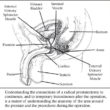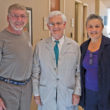Themes in Radiation Oncology for 2020
Among the themes of radiation therapy for prostate cancer this year are a shift towards shorter courses giving higher radiation doses per course, called “hypofractionation,” which are more convenient, more cost-effective, and achieve similar control of the disease. Also, there is increasing attention to patient-reported outcomes of quality of life, which is important because the long-term survival of prostate cancer treatment is generally good. Other studies are underway to further define the role of hormonal therapy with radiation therapy and how to balance the benefits and risks of hormonal therapy with regard to indications, timing, and length of treatment. In addition, there are new results of postoperative radiation therapy for improving survival regarding timing and dose of radiation therapy and the appropriate use of concomitant hormonal therapy.

In science, just as nature, exploration can provide a new point of view.
Study Suggests Higher Doses of Radiation More Effective at Stopping Cancer Spread
A clinical trial tested the effectiveness of giving patients higher doses of radiation therapy. About 300 patients were randomly split into two different groups: a traditional radiation therapy group and a “dose escalated” group that received higher doses of radiation.
Patients who had traditional radiation treatment had a total dose of 70 Gray (Gy) of radiation over 35 visits. Patients in the “dose escalated” group had a total dose of 78 Gy over 39 visits (7 to 8 weeks)
After fifteen years, patients who had the higher doses of radiation were less likely to die of prostate cancer: 3% of these patients died from the disease, compared to 6% of patients who had the lower dose.
Men in the higher dosage group were also less likely to have distant metastasis, in which the cancer spread far beyond the prostate, such as to the bones or other organs. About 1% of patients with the higher doses had distant metastasis, compared to 3.4% of patients that had traditional dose levels.
For overall survival, the results in the two groups were statistically comparable.
However, more patients who started at the lower dosage had “salvage radiation,” which are subsequent rounds of radiation used to stop or slow further cancer spread. Almost 39% of patients in the lower dose group had salvage radiation, compared to about 22% of patients in the higher dose group in their first round of treatment.
Dr. Catalona’s Response:
The results of this long-term clinical trial continue to demonstrate an improvement in results with a higher dose of radiation therapy; however, it has not yet shown to affect overall survival.
Shifting to “Hypofractionation”: Fewer Radiation Sessions with Higher Dosages Had Similar Results for Prostate Cancer Patients
Standard external beam radiation treatment for prostate cancer involves men going for outpatient treatment five days a week for 7 to 8 weeks. The downsides of this are the time commitment, as well as the prolonged length of time that men have to deal with side effects.
A new focus of research is hypofractionation, in which larger dosages of radiation are given over less treatment sessions, resulting in an overall shorter period of treatment.
A large randomized study published last year looked at “ultra- hypofractionation,” which reduced the number of treatment sessions to just seven. Patients were randomly assigned to a group that had traditional radiation therapy dose of 78 Gy for 39 sessions, or a hypofractionated group that had 42.7 Gy for just seven sessions.
The two treatment groups were about equally effective in preventing cancer spread. After five years, 84% of men in both groups had success in their cancer not progressing further. More men in the hypofractionated group had early side effects, such as bowel or urinary problems. However, after five years the same number of patients in both groups reported continued side effects.
Nearly 1,200 patients participated in the study. The patients did not have androgen-deprivation therapy (ADT, also known as hormone or hormonal therapy), which is known to enhance the effectiveness of radiation treatment for prostate cancer.
Dr. Catalona’s Response:
This clinical trial tests the efficacy of a shorter course of radiation therapy that is now being used in about 17% of radiation therapy cases in the U.S. However, “hypofractionation” will probably be used more commonly in the COVID-19 pandemic era to reduce exposure of patients to the radiation-care facility. Compared to more modest “hypofractionation” protocols, this study gives a much larger dose of radiation in only seven treatments (over 21⁄2 weeks). It shows that seven days is not inferior to 39 days for preventing treatment failure at five years of follow-up, and the increased side effect differences are mild and only observed in the early-term for urinary function.
Research Finds a Better Approach: Combining Hormonal Therapy and Radiation When Prostate Cancer Comes Back
Men whose cancer comes back after surgery may need to have “salvage radiation therapy” to target growing cancer cells. A study called GETUG-AFU 16 sought to determine whether combining short-term hormonal therapy (also known as androgen-deprivation therapy, ADT, or hormone therapy) with salvage radiation therapy would be better at preventing further cancer growth.
Researchers randomized 743 patients whose PSA increased after their prostatectomy to one of two groups. The patients received either short-term hormonal therapy plus radiation, or radiation therapy alone.
After more than nine years, it appeared that the combined treatment approach was better. Adding hormonal therapy to radiation significantly reduced the risk of cancer recurrence. Sixty-four percent of patients who received combined treatment did not have cancer recurrence, compared to 49% for patients in the radiation only group.
The combined treatment also reduced the risk of death from prostate cancer.
Dr. Catalona’s Response:
Hormonal therapy is well-known to improve the outcomes of radiation therapy for prostate cancer. The long-term outcomes of this clinical trial now show progression-free and metastases-free survival benefits with concomitant hormonal therapy. The benefit is observed in both low-risk and high-risk patients. The authors suggest that to maximize the benefits of postoperative radiation therapy, one should consider using concomitant hormonal therapy in everyone receiving salvage radiation therapy. How long it should be given is uncertain, but longer is probably indicated for higher-risk disease and patients with higher PSA levels at the time of salvage radiation. Nevertheless, there are no randomized data to guide us. Men with the lowest-risk factors do not benefit as much, and it must be considered that hormonal therapy has its own substantial side effects.
For Men with Margin-Positive Prostate Cancer, Radiation Immediately After Surgery May Curb Disease Spread
Sometimes, when a man with prostate cancer has a radical prostatectomy, the surgeon discovers that the cancer has “positive margins,” which means the cancer has spread to the edge of the prostate or slightly beyond. Radiation can be used to kill the remaining cancer cells, but there are two options for when to start the treatment.
The first is “adjuvant radiation,” which means having radiation therapy as soon as the man recovers urinary continence after surgery. The second option is “salvage radiation,” which means waiting until there is evidence of further cancer growth before starting radiation.
To address the question of which is more effective, a Finnish study randomized 250 men with prostate cancer and positive margins into two groups. The first group received adjuvant radiation therapy as soon as possible after their radical prostatectomy. The second group was observed after their surgeries and only received radiation therapy if their PSA rose above 0.5, indicating their cancer had started to grow.
After 10 years, the men who had adjuvant radiation were less likely to have cancer spread later. Eighty-two percent of men in the adjuvant radiation group did not have cancer recurrence, compared to 61% of men who were observed after surgery and had radiation only after their PSAs began to rise. However, the survival rates after 10 years were nearly identical.
Some men who participated in the study did not have cancer recurrence within the 10- year period the researchers followed them, despite the positive margins discovered during surgery. Men in this group who were assigned to the salvage radiation group were able to avoid radiation therapy altogether, and therefore avoided the continence and sexual potency side effects that can sometimes occur during radiation treatment.
Dr. Catalona’s Response:
The question of when to initiate postoperative radiation therapy has been a big topic. This is a study that compares “adjuvant” radiotherapy to observation with early salvage radiation therapy only if needed. Although early adjuvant therapy reduced the tumor recurrence rate, the long-term survival outcome was the same, and the side effects of the adjuvant radiation therapy were greater. Therefore, delaying radiation therapy did not seem to compromise the endpoint, and some patients could completely avoid postoperative radiation therapy. Thus, it is sensible to consider observation for men with intermediate-risk disease.




















